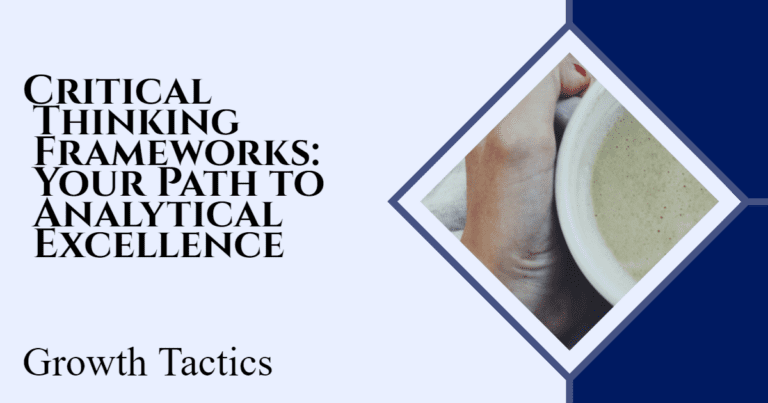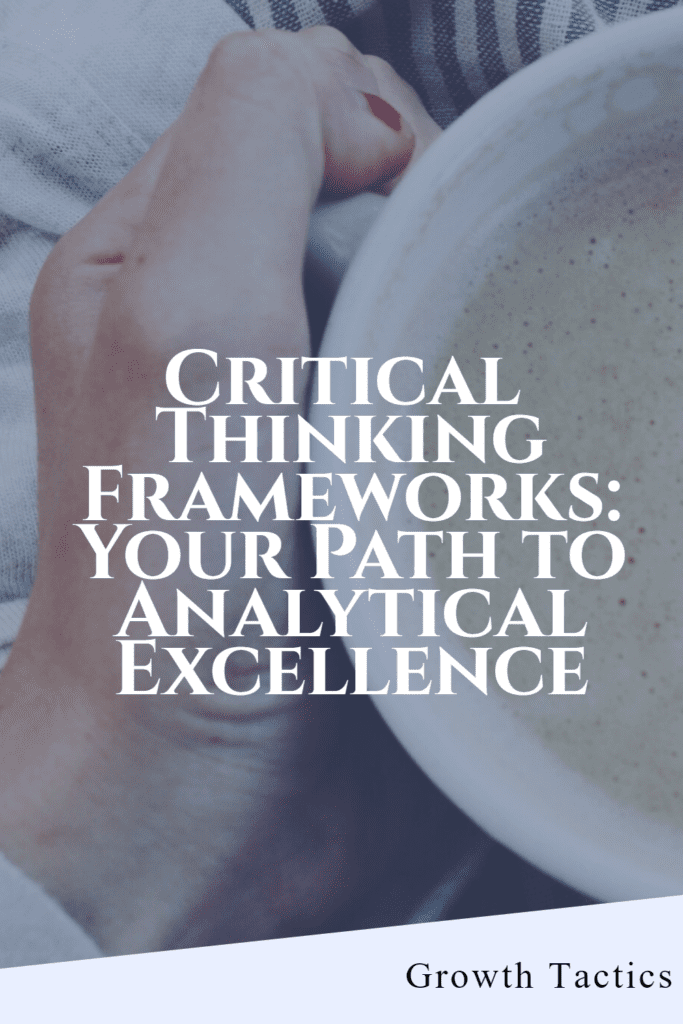Are you ready to dive deeper into the world of critical thinking? Today, we’ll focus on the essential concept of critical thinking frameworks. These frameworks provide us with a structured approach to analyzing information, solving problems, and making sound decisions. So, let’s explore the power of critical thinking frameworks and discover how they can enhance our thinking process.
Jump To Section
Understanding Different Critical Thinking Frameworks
When it comes to critical thinking frameworks, there are various models and approaches to explore. In this section, we’ll examine some popular frameworks such as the Paul-Elder model, the RED model, and Bloom’s Taxonomy. Each framework brings its unique perspective and structure to guide our critical thinking journey. Get ready to unlock a wealth of knowledge!
The Paul-Elder Model: A Holistic Approach to Critical Thinking
At the core of the Paul-Elder model lies the belief that critical thinking is an active and intentional process, driven by disciplined thought. It provides us with a set of intellectual standards and dimensions to guide our thinking, ensuring that we’re thorough, accurate, and clear in our analysis. So, let’s explore the key components that make up this remarkable framework.
Clarity: Shining a Light on Our Thoughts
The first component of the Paul-Elder model is clarity. It’s all about expressing our thoughts and ideas in a clear and unambiguous manner. By striving for clarity, we ensure that our message is easily understood and that we’re able to communicate our thinking effectively. This involves being aware of our language, avoiding jargon, and using precise terminology to convey our ideas with precision.
Accuracy: Seeking Truth in All Its Forms
The pursuit of accuracy is crucial in critical thinking. It involves challenging assumptions, verifying facts, and seeking evidence to support our claims. By striving for accuracy, we aim to align our thinking with reality and separate the truth from falsehoods. This component encourages us to be meticulous in our research, to question sources, and to analyze information critically before accepting it as truth.
Relevance: Focusing on What Truly Matters
In a sea of information, it’s essential to determine what’s relevant to our thinking. The relevance component of the Paul-Elder model urges us to filter out the noise and focus on what truly matters. It requires us to identify the key elements, concepts, and ideas that are most significant to the task at hand. By embracing relevance, we can streamline our thought processes, saving time and energy for what truly counts.
Logic: Unraveling the Threads of Reasoning
Logical thinking forms the backbone of the Paul-Elder model. This component encourages us to analyze the coherence and consistency of our reasoning. It prompts us to identify any logical fallacies or inconsistencies that may weaken our arguments. By using logical reasoning as a guiding principle, we can build well-structured and sound arguments that carry weight and persuade others effectively.
Depth: Digging Beneath the Surface
Critical thinking is not just about skimming the surface; it’s about diving deep and exploring the underlying complexities. The depth component of the Paul-Elder model challenges us to go beyond the obvious, to question assumptions, and to explore alternative perspectives. By delving beneath the surface and seeking a profound understanding, we enrich our thinking and unlock valuable insights.
Fairness: Embracing Objectivity and Open-Mindedness
Fairness is an integral part of the Paul-Elder model and critical thinking as a whole. It involves approaching information and ideas with an open mind, free from bias or preconceived notions. Fairness recognizes the importance of considering multiple perspectives, including those that challenge our own beliefs. By fostering a fair and impartial mindset, we encourage intellectual growth and broaden our understanding of the world.
Putting the Paul-Elder Model into Action
Now that we understand the key components of the Paul-Elder model, it’s time to put it into action. By incorporating these elements into our thinking process, we can enhance our critical thinking skills and become more effective problem solvers. As we practice this holistic approach, we’ll find ourselves making better decisions, evaluating information more effectively, and communicating our thoughts with clarity and conviction.
In the journey toward mastering critical thinking, the Paul-Elder model serves as a guiding light, providing us with the tools to navigate the vast sea of information that surrounds us. By embracing clarity, accuracy, relevance, logic, depth, and fairness, we can cultivate a well-rounded thinking process that empowers us to tackle complex issues head-on.
The RED Model: Break it Down to Think Clearly
In this section, we’re diving into the world of the RED model, a powerful framework designed by the brilliant minds of Dr. Richard Paul and Dr. Linda Elder.
This model acts as a compass, guiding us to think critically and clearly by breaking down the thinking process into three simple steps: Recognize, Evaluate, and Draw Conclusions. So, let’s dig in and discover how the RED model can help us navigate the complexities of our thoughts.
Recognize: Shining a Light on Our Thinking Patterns
The first step of the RED model is all about recognizing and becoming aware of our thinking. It challenges us to examine the patterns, assumptions, and biases that shape our thoughts. By shining a light on our thinking process, we can identify any potential flaws or limitations. This step is crucial as it lays the foundation for unbiased and objective reasoning.
To recognize our thinking, we must pause and reflect. Are we making assumptions without solid evidence? Are we being influenced by personal biases? By being aware of these thought patterns, we can approach information with a more critical eye and open ourselves to new possibilities.
Evaluate: Putting Our Thinking Under the Microscope
Once we’ve recognized our thinking, it’s time to evaluate it with precision. This step involves analyzing the quality of our reasoning, the strength of the evidence, and the validity of our arguments. Are our claims supported by sound evidence? Are there any logical fallacies in our thinking? By evaluating our thoughts, we ensure that they’re built upon a solid foundation.
Evaluation also requires us to consider different perspectives and challenge our own assumptions. It’s about seeking out diverse viewpoints and weighing them against our own beliefs. This step allows us to build a more comprehensive understanding of the issue at hand.
Draw Conclusions: Illuminating the Path Forward
After recognizing and evaluating our thinking, it’s time to draw conclusions. This step is about making informed decisions based on our analysis. By drawing conclusions, we reach a point where we can confidently articulate our thoughts and take action.
Drawing conclusions involves synthesizing the information we’ve gathered, considering all relevant factors, and coming to a well-reasoned resolution. It’s about being clear and concise in our communication of ideas, ensuring that others can understand and engage with our thoughts effectively.
The Power of the RED Model in Action
By breaking down the thinking process into three simple steps, the RED model empowers us to think clearly and critically. It provides a structured framework that guides us through the complexities of our thoughts, helping us avoid jumping to conclusions or being swayed by bias.
The RED model encourages a disciplined and systematic approach to thinking. It prompts us to question our assumptions, evaluate evidence with care, and communicate our thoughts with clarity. Through practice and repetition, this model becomes ingrained in our thinking process, enabling us to make more informed decisions and solve problems effectively.
Applying the RED model in our daily lives
The beauty of the RED model is its versatility. We can apply it to various situations, from personal decision-making to problem-solving in our professional lives. Whether we’re analyzing an argument, evaluating a piece of information, or making a strategic choice, the RED model helps us approach these tasks with a clear and critical mindset.
As we embrace the RED model and make it a part of our thinking routine, we’ll notice a transformation in our analytical abilities. We’ll become more adept at recognizing our thinking patterns, evaluating evidence objectively, and drawing well-grounded conclusions. The RED model empowers us to think critically and make thoughtful decisions in an increasingly complex world.
Bloom’s Taxonomy: From Knowledge to Evaluation
Developed by educational psychologist Benjamin Bloom, this taxonomy provides a roadmap for mastering new concepts and deepening our understanding. So, let’s dive right in and explore how Bloom’s Taxonomy can fuel our learning adventures.
Building Blocks: Knowledge and Comprehension
At the foundation of Bloom’s Taxonomy lie two essential building blocks: knowledge and comprehension. Knowledge involves acquiring facts, terms, and basic concepts about a subject. It’s the starting point where we gather the essential information necessary to understand a topic. Once we have this knowledge, we can move on to comprehension.
Comprehension goes a step beyond knowledge. It’s about grasping the meaning of the information we’ve acquired. This phase involves interpreting, explaining, and summarizing concepts in our own words. Comprehension helps solidify our understanding and fuels our ability to analyze and apply knowledge effectively.
Putting Ideas into Practice: Application and Analysis
With a solid foundation of knowledge and comprehension, we’re ready to put our ideas into practice. The next two levels of Bloom’s Taxonomy, application, and analysis, take us into the realm of practicality and critical thinking.
Application invites us to take what we’ve learned and apply it to real-life situations. It’s about utilizing our knowledge and comprehension to solve problems, make connections, and demonstrate our understanding. This level of Bloom’s Taxonomy encourages us to think creatively and transfer our knowledge to new contexts.
Analysis takes our thinking a step further. It involves breaking down complex information, examining its parts, and understanding the relationships between them. Analysis challenges us to think critically, identify patterns, and draw conclusions based on evidence. This level hones our ability to delve deeper and unravel the complexities within a subject.
Reaching New Heights: Synthesis and Evaluation
As we ascend Bloom’s Taxonomy, we encounter the higher-order thinking skills of synthesis and evaluation. These levels push us to tap into our creativity, critical thinking, and judgment.
Synthesis prompts us to integrate various ideas, concepts, and information to create something new. It’s about putting the puzzle pieces together in a unique way and constructing a cohesive whole. Synthesis stretches our imagination and encourages us to think outside the box, fostering innovation and originality.
Finally, we reach the pinnacle of Bloom’s Taxonomy: evaluation. This level challenges us to make judgments, form opinions, and assess the value and effectiveness of ideas or arguments. Evaluation requires us to consider evidence, weigh different perspectives, and make informed decisions. It’s the critical thinking skill that empowers us to be discerning, reflective, and confident in our assessments.
Mastering Bloom’s Taxonomy for Lifelong Learning
By embracing the levels of Bloom’s Taxonomy, we unlock the power to become lifelong learners. This framework equips us with the tools to progress from knowledge to evaluation, building a solid foundation of understanding along the way. Whether we’re studying for exams, conducting research, or simply expanding our knowledge, Bloom’s Taxonomy serves as our trusty guide, motivating us to think critically and deeply explore the subjects we’re passionate about.
As we climb the ladder of Bloom’s Taxonomy, let’s embrace each level as an opportunity for growth and personal development. Let’s ask questions, seek answers, and challenge ourselves to reach new heights of understanding. By nurturing our curiosity and honing our thinking skills, we’ll become lifelong learners, continuously expanding our knowledge and making meaningful contributions in our chosen fields.
Wrap-Up
By focusing on critical thinking frameworks, you’ve equipped yourself with valuable tools for analyzing information and making informed decisions. Remember, applying these frameworks is a continuous journey of practice and refinement. Embrace the versatility of different frameworks, experiment with their integration, and be open to new perspectives.
Now, armed with this newfound knowledge, you’re ready to tackle complex challenges with confidence and precision. Whether you’re a student, professional, or lifelong learner, mastering critical thinking frameworks will empower you to navigate the world with analytical excellence.


